In our exploration of Jewish history, we’ve journeyed through the dynamic interplay between tradition and modernity. In the 18th and early 19th centuries, a new movement known as the Haskalah emerged in Western Europe, profoundly impacting the Jewish world. The Haskalah, meaning “enlightenment” in Hebrew, represented a departure from traditional Jewish thought and a willingness to engage with the broader world, even at the risk of assimilation. This movement marked a pivotal chapter in the evolution of Jewish identity, and in this blog, we’ll delve deeper into the Haskalah’s origins and its enduring influence.
Elevate your understanding of our shared heritage by embarking on an enriching journey with Jewish Cruises, offered by Kosher River Cruises. Set sail in exquisite style, indulge in gourmet kosher cuisine, and partake in daily services that deepen your connection. Immerse yourself in captivating destinations while enjoying the lap of luxury on board. Transform your vacation into a truly unique Jewish experience that goes beyond the ordinary.
The Emergence of the Haskalah
The term “Haskalah” was a Hebrew translation of the German term used in the 18th century to describe a wave of rationalism and humanism sweeping Western Europe. While its roots can be traced back to earlier thinkers like Azariah dei Rossi in the 16th century, the Haskalah marked a more radical embrace of the outside world. It was a period of looking beyond Jewish tradition and engaging with broader society.
The Haskalah gained momentum due, in part, to the experiences of forcibly converted Portuguese Jews who maintained a dual identity. They recognized the richness of their Jewish heritage while resenting their Christian passports. This tension between maintaining a distinct Jewish identity and engaging with the wider world was a central theme of the Haskalah.
Moses Mendelssohn: A Bridge Between Two Worlds

A picture of Moses Mendelssohn displayed in the Jewish Museum, Berlin, based on an oil portrait (1771) by Anton Graff in the collection of the University of Leipzig. | (c) en.wikipedia.org/wiki/Moses_Mendelssohn
At the heart of the Haskalah movement was Moses Mendelssohn, a self-taught genius who was celebrated not only for his philosophical work but also for his command of secular German. His ability to bridge the gap between Jewish and German culture made him a revered figure. Mendelssohn advocated for the value of Jewish culture and tradition while promoting the study of German language and culture among traditional observant Jews. He remained a devoutly observant Jew himself, demonstrating that Jews could excel in both worlds.
Diverse Approaches within the Haskalah
The Haskalah movement was not monolithic, and its leaders had diverse approaches. While Mendelssohn sought a harmonious coexistence of Judaism and wider culture, others advocated for a more radical break from tradition. This diversity sparked significant debates and controversies within the Jewish community.
One such controversy was the false burial decree of 1772, driven by fears of premature burial. This challenged traditional Jewish burial practices and highlighted the tensions between tradition and the changing world of the Enlightenment.
Negotiating Tradition and Modernity
The Haskalah era saw Jews grapple with the challenge of reconciling tradition and modernity, as well as their place in civic society. Moses Mendelssohn played a pivotal role in articulating a statement that could be acceptable to all. Debates about Jewish emancipation and equal rights often hinged on how Jews were perceived in broader society.
Some Jews contemplated conversion to Christianity as a means of gaining acceptance, while others, like Rabbi Samson Raphael Hirsch, advocated for a balanced approach that embraced elements of modernity without forsaking Jewish identity and commandments.
Contrasting Western and Eastern Europe
Western and Eastern Europe had distinct experiences during this period. Western European Jewry, with a smaller population, was more open to modern ideas and had a leaning towards assimilation. In contrast, Eastern Europe had a larger, more concentrated Jewish community deeply rooted in its culture. Acculturation rather than assimilation was the emphasis in the East, involving adaptation rather than abandonment of Jewish ideals.
The Impact on Modern Jewish Identity
Today, the legacies of the Chassidim, Misnagdim, and the Maskilim continue to shape Jewish identity. These movements, each with its unique approach to tradition and modernity, exist in dynamic tension, reflecting the ongoing negotiation of what it means to be a Jew in the modern world.
The Haskalah, with its call for enlightenment and engagement with the broader world, remains a pivotal chapter in the ongoing story of Jewish identity. It reminds us of the enduring questions faced by Jews throughout history: How can tradition be preserved in a changing world? How can one be both Jewish and a citizen of the world? These questions, posed centuries ago, continue to resonate with Jews today, as they navigate the complexities of modernity while holding onto their rich heritage.
Learn More About Our Jewish History Aboard Jewish Cruises
Exploring the depths of our shared Jewish heritage is akin to unraveling the intricate tapestry of our history, shedding light on our collective narrative. To truly immerse yourself in this enriching experience, we extend a warm invitation to accompany us on one of our extraordinary Kosher riverboat cruises. Seamlessly blending the pleasures of exploration with the reassuring embrace of kosher luxury, this is more than a mere vacation; it’s an expedition of culture, connection, and our shared history.
